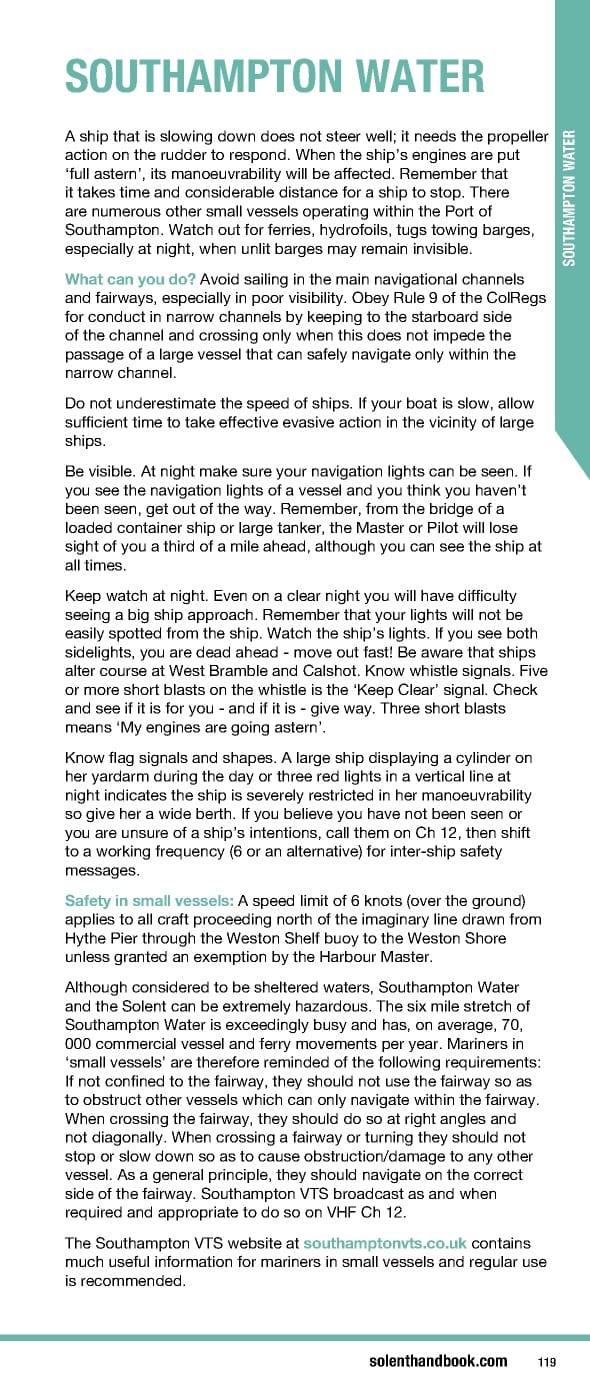SOUTHAMPTON WATER A ship that is slowing down does not steer well; it needs the propeller TER action on the rudder to respond. When the ship’s engines are put A ‘full astern’, its manoeuvrability will be affected. Remember that it takes time and considerable distance for a ship to stop. There are numerous other small vessels operating within the Port of Southampton. Watch out for ferries, hydrofoils, tugs towing barges, especially at night, when unlit barges may remain invisible. SOUTHAMPTON W What can you do? Avoid sailing in the main navigational channels and fairways, especially in poor visibility. Obey Rule 9 of the ColRegs for conduct in narrow channels by keeping to the starboard side of the channel and crossing only when this does not impede the passage of a large vessel that can safely navigate only within the narrow channel. Do not underestimate the speed of ships. If your boat is slow, allow sufficient time to take effective evasive action in the vicinity of large ships. Be visible. At night make sure your navigation lights can be seen. If you see the navigation lights of a vessel and you think you haven’t been seen, get out of the way. Remember, from the bridge of a loaded container ship or large tanker, the Master or Pilot will lose sight of you a third of a mile ahead, although you can see the ship at all times. Keep watch at night. Even on a clear night you will have difficulty seeing a big ship approach. Remember that your lights will not be easily spotted from the ship. Watch the ship’s lights. If you see both sidelights, you are dead ahead - move out fast! Be aware that ships alter course at West Bramble and Calshot. Know whistle signals. Five or more short blasts on the whistle is the ‘Keep Clear’ signal. Check and see if it is for you - and if it is - give way. Three short blasts means ‘My engines are going astern’. Know flag signals and shapes. A large ship displaying a cylinder on her yardarm during the day or three red lights in a vertical line at night indicates the ship is severely restricted in her manoeuvrability so give her a wide berth. If you believe you have not been seen or you are unsure of a ship’s intentions, call them on Ch 12, then shift to a working frequency (6 or an alternative) for inter-ship safety messages. Safety in small vessels: A speed limit of 6 knots (over the ground) applies to all craft proceeding north of the imaginary line drawn from Hythe Pier through the Weston Shelf buoy to the Weston Shore unless granted an exemption by the Harbour Master. Although considered to be sheltered waters, Southampton Water and the Solent can be extremely hazardous. The six mile stretch of Southampton Water is exceedingly busy and has, on average, 70, 000 commercial vessel and ferry movements per year. Mariners in ‘small vessels’ are therefore reminded of the following requirements: If not confined to the fairway, they should not use the fairway so as to obstruct other vessels which can only navigate within the fairway. When crossing the fairway, they should do so at right angles and not diagonally. When crossing a fairway or turning they should not stop or slow down so as to cause obstruction/damage to any other vessel. As a general principle, they should navigate on the correct side of the fairway. Southampton VTS broadcast as and when required and appropriate to do so on VHF Ch 12. The Southampton VTS website at southamptonvts.co.uk contains much useful information for mariners in small vessels and regular use is recommended. 119 solenthandbook.com
 Solent Handbook & Directory April 2023- March 2024 Page 118 Page 120
Solent Handbook & Directory April 2023- March 2024 Page 118 Page 120